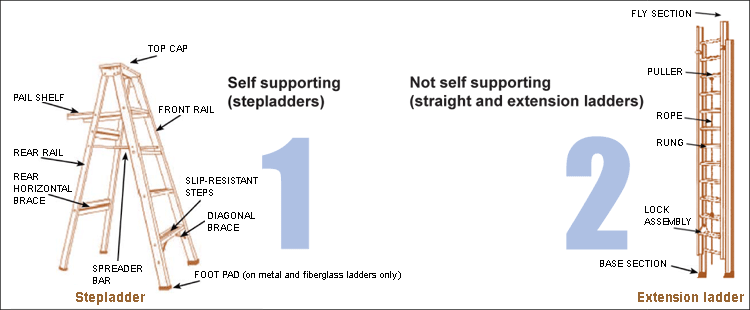Design and Construction
Portable ladders are constructed with a variety of materials. They can be self supporting or not self supporting, and can be of different sizes. All portable ladders have duty ratings based on the work load the ladders can handle. These variations provide users a wide selection of choices for portable ladders to meet different needs.
The design and construction of ladders are also done in numerous ways in order to help users accomplish the task on hand in a safe manner. The requirements on the design and construction of both portable ladders are given in T8 CCR Section 3276. These requirements insure the safety of portable ladders under normal conditions of usage.
Material of Construction
Ladders can be made of metal, wood, reinforced plastic or fiberglass. The most common material is aluminum. Metal ladders should never be used for work on or around exposed electrical elements; a wood or fiberglass ladder is necessary. However, refer to warning labels on the ladder or the manufacturer’s directions because some nonmetal ladders are reinforced with steel or other conductive materials.
Portable ladders shall meet the design and construction requirements for the material of construction as follows:
| Portable Ladder Material | In Service After January 7, 2011 |
In Service On or Before January 7, 2011 |
Exception |
|---|---|---|---|
| Wood | ANSI A14.1-2007, American National Standard for Ladders - Wood Safety Requirements | ANSI A14.1 standard in effect at the time such ladders were placed in service | Portable job-made cleat ladders that are designed and constructed in accordance with the requirements of Section 1676 of the Construction Safety Orders |
| Metal | ANSI A14.2-2007, American National Standard for Ladders - Portable Metal - Safety Requirements | Either the ANSI A14.2 standard or the ANSI A14.10 standard, American National Standard for Ladders - Portable Special Duty Ladders, in effect at the time such ladders were placed in service | |
| Reinforced Plastic | ANSI A14.5-2007, American National Standard for Ladders - Portable Reinforced Plastic - Safety Requirements | Either the ANSI A14.5 standard or the ANSI A14.10 standard in effect at the time such ladders were placed in service |
Self Supported/Not Self Supported Ladders
There are two basic types of portable ladders in terms of how the ladder is supported:
- Self supporting – Stepladders
- Not self supporting – Single and Extension Ladders

Step Ladder
A step ladder is a self-supporting portable ladder, nonadjustable in length, having flat steps and a hinged back. Its size is designated by the overall length of the ladder measured along the front edge of the side rails.
Extension Ladder
An extension ladder is a non-self-supporting portable ladder adjustable in length. It consists of two or more sections traveling in guides or brackets so arranged as to permit length adjustment. Its size is designated by the sum of the lengths of the sections measured along the side rails.
Single Ladder
A single ladder is a non-self-supporting portable ladder, nonadjustable in length, consisting of but one section. Its size is designated by the overall length of the side rail.
Size of Portable Ladder
Users should not use portable ladders that are longer than the maximum length allowed under any circumstances. The maximum length allowed for each type of ladder is provided below:
| Ladder Type | Maximum Length (Feet) |
|---|---|
| Step ladder | 20 |
| Two-section extension ladder (wood) | 60 |
| Two-section extension ladder (metal) | 48 |
| Three-section extension ladder (metal) | 60 |
| Two-section extension ladder (reinforced plastic) | 72 |
| Trestle ladder | 20 |
| Extension trestle ladder base section | 20 |
| Extension trestle ladder extension section | 20 |
| Painter's step ladder | 12 |
| Mason's ladder | 40 |
| Cleat ladder | 30 |
| Trolley ladder or side-rolling ladder | 20 |
| Single ladder | 30 |
When using a two section extension ladder, remember that the overlap between the sections can't be less than the following minimum overlap length:
| Ladder Size (Feet) | Minimum Overlap (inches) |
|---|---|
| Up to and including 32 | 36 |
| Over 32, up to and including 36 | 46 |
| Over 36, up to and including 48 | 58 |
| Over 48, up to and including 60 | 70 |
Duty Rating
Using ladder of proper duty rating is an extremely important safety consideration. Follow the duty classifications given in the table below while selecting/using the ladder for your job:
| Duty Rating | Ladder Type | Working Load (pounds) |
|---|---|---|
| Special Duty | IAA | 375 |
| Extra Heavy-Duty | IA | 300 |
| Heavy-Duty | I | 250 |
| Medium-Duty | II | 225 |
| Light-Duty | III | 200 |
Other Design and Construction Considerations
- Other portable special purpose ladders that are not covered above shall be designed and constructed in accordance with sound engineering principles.
- Remember that the ladder type step stools (32” or less in length) shall be designed and constructed such that the rungs, cleats, and steps are not less than 8 inches apart, or more than 12 inches apart, as measured between center lines of the rungs, cleats, and steps.


